Dateline: Charlottesville, Virginia, August, 2017. The Confederate battle flag flies high on one side of the police line even as it burns on the other. The flashpoint? Robert Edward Lee, a monument to the Confederate general. On one side of the ramparts, he is a tragic hero; on the other, the perfect embodiment of the nation’s original sin. Why has this college town’s proposal to topple a metal statue inspired so much passion?
Because, of course, memorials are more than just bronze and marble. “All wars are fought twice, the first time on the battlefield and the second time in memory,” writes novelist Viet Tanh Nguyen. Clearly, the Civil War’s origins continue to be contested a century and a half after Appomattox.
Memory is a battlefield, and monuments are built on this contested ground. They are fronts on political theaters of war: sites where vying factions negotiate history, a society’s identity, and, consequently, its political future. Victors often erect monuments memorializing the heroes of their conquests, working to promote stories about the past that legitimize their authority. Power, though, tends to invite challenge. Those who do not share the political visions inherent in such shrines sometimes engage in iconoclasm, altering or destroying monuments.
Despite claims to the contrary, altering, removing, or destroying a monument does not constitute an erasure of history. Rather, it signals a reevaluation of how that episode of the past should be collectively remembered. The toppling of statues has occurred for the same reasons they were erected in the first place: to construct a collective memory which aligns with the political ideals of a society. As the public debates the merits of the #RhodesMustFall and #TakeThemDown movements, here are ten episodes in the history of monument takedowns which illustrate this point.
1. Damnatio Memoriae in Ancient Rome
Iconoclasm stretches back to the early years of Western Civilization. In the Roman Empire, emperors were subject to an evaluation by the Senate after their death. Senators would either grant the emperor a cult in the Roman religion (apotheosis) or would cast damnatio memoriae upon him. If the Senate decided on “condemnation of memory” for an unpopular, unpalatable, or politically divisive emperor, all official monuments carrying his likeness would be destroyed. In some cases, successors to the imperial throne obstructed the damnatio memoriae of their predecessors for political reasons. Caligula’s legacy was saved by Claudius; that of Nero’s by Vitellius. Damnatio memoriae was most common after regime change. Note however, that the names of these emperors were not lost to history.
2. Byzantine Iconoclasm
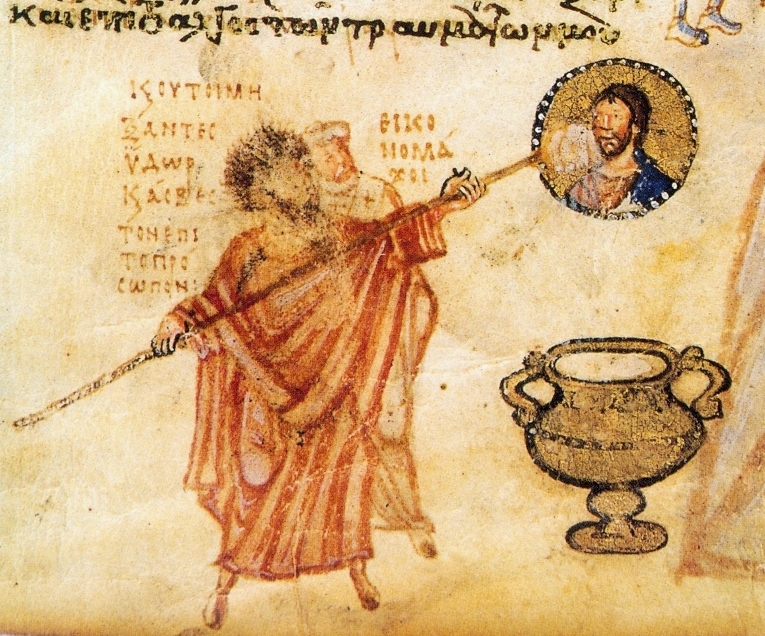
Despite early church adherents’ opposition to depictions of Jesus, by the 7th century, many Byzantine Christians subscribed to their religious use. However, Byzantine Emperor Leo III outlawed the use of icons in 730 CE. This led to a rash of destruction of paintings, statues, and engravings depicting Christ. A possible motive for this destruction was that Iconoclasts coveted the material wealth and political power of the clergy as manifest in their icons. Emperor Leo III used his forces to officially persecute worshipers of icons, with bloody results. However, following the seventh Council of Nicaea in the 9th century, Iconoclasm was outlawed. The restoration of icons is commemorated today as the “Feast of Orthodoxy.”
3. A Papal Statue Destroyed in Renaissance Italy
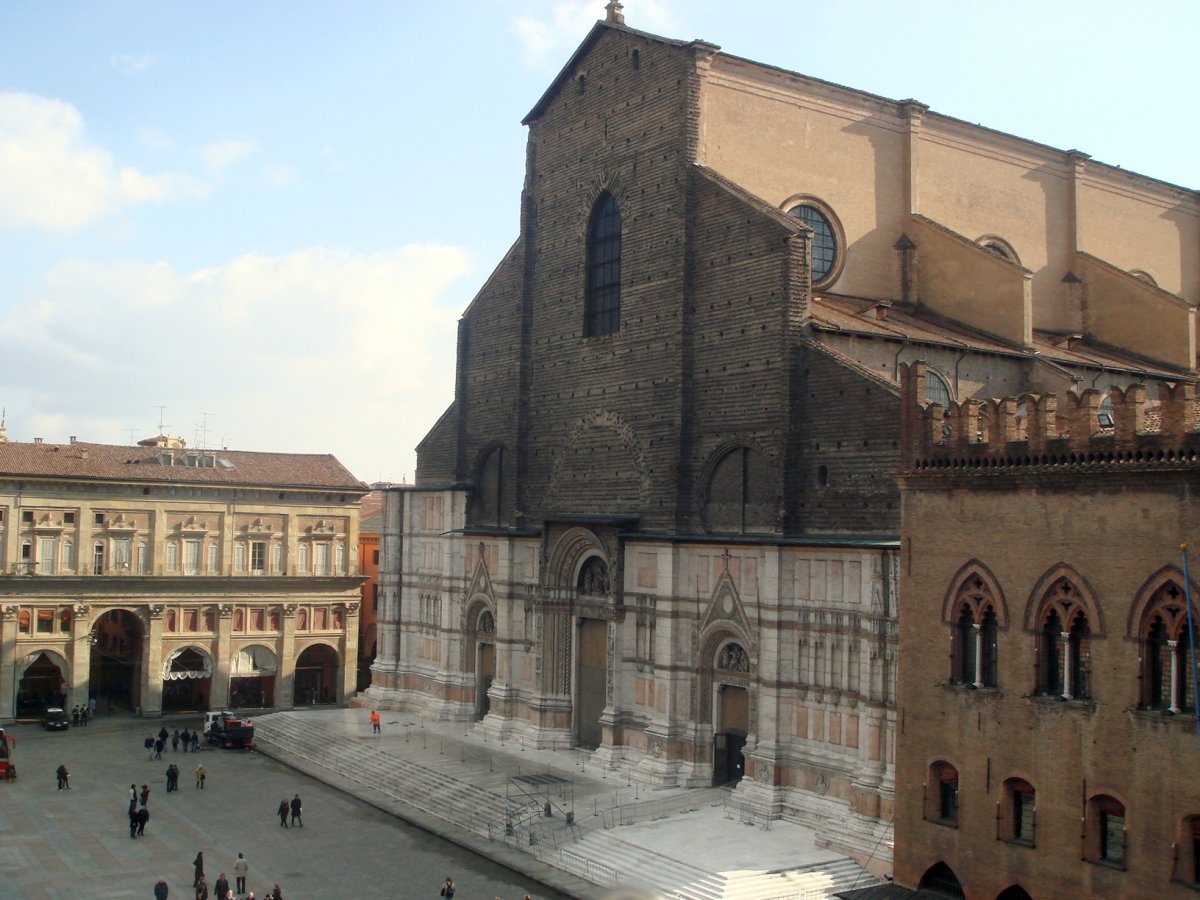
Sixteenth-century Italy was the site of much political turmoil as well as serving as the birthplace of many of the Western canon’s great works of art. When Pope Julius II’s troops overtook the rebellious city of Bologna, il papa commissioned Michelangelo to carve his likeness. The bronze statue, which took the master longer to finish than David, was installed atop the entrance to Bologna’s main basilica, San Petronio, in 1508. When the enemies of Julius II wrested back control of the city two years later, they toppled this symbol of papal authority. Instead of entering the canon, Julius II was melted into cannon fodder.
4. Protestant Iconoclasm following The Reformation
![]()
After Martin Luther initiated what would become the Protestant Reformation, many Protestants targeted Catholic icons as symbols of idolatry and corruption. Throughout the 16th century, Protestant mobs and authorities destroyed relics and stripped them of their precious metals in Switzerland, Denmark, Germany, Belgium, Northern France, and Scotland. The heads of the saints depicted at the altar of the Cathedral of Saint Martin in Utrecht were decapitated by Protestant iconoclasts. In the mid-17th century, Oliver Cromwell’s Puritan government passed a parliamentary resolution against “superstition and idolatry” and much iconoclasm ensued. The destruction of monuments during the Reformation was as often motivated by political and economic inducements as it was by theological fervor.
5. Iconoclasm, American Style
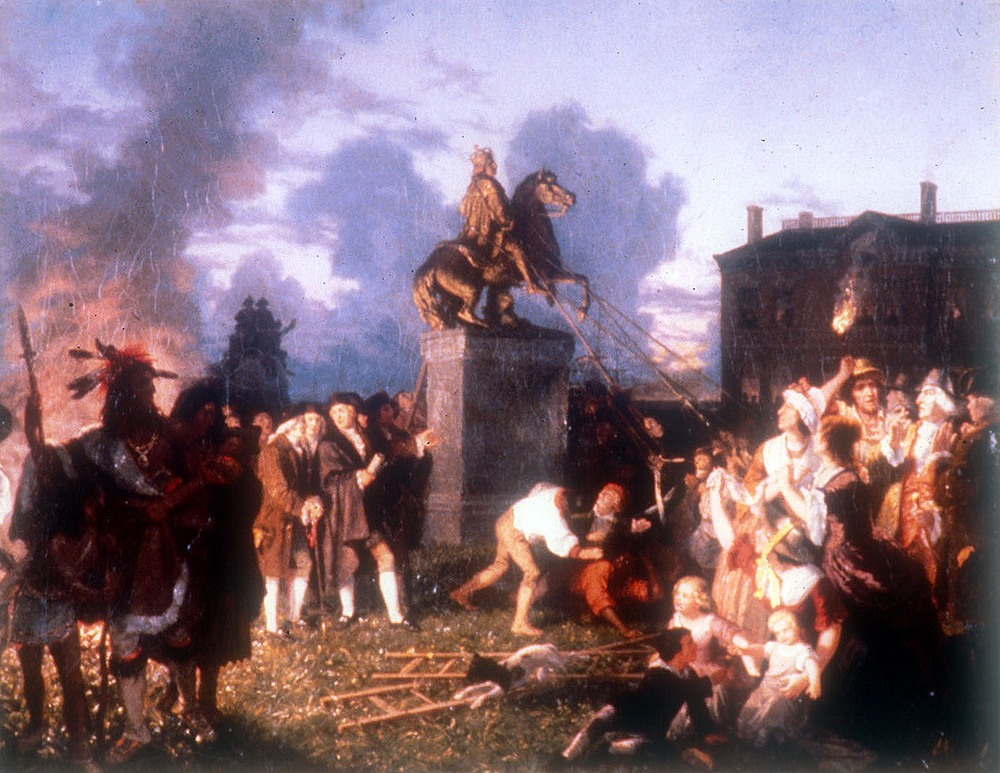
American history is no stranger to monument takedowns. In early July 1776, American patriots gathered in New York City to hear for the first time a reading of the recently-penned Declaration of Independence. Thereafter, members of the radical Sons of Liberty, overtaken with revolutionary fervor, marched on Bowling Green. There stood a 4,000 pound statue of reigning King George III. This likeness of King George had been commissioned to commemorate the repeal of the Stamp Act. In defiance of the Crown, the mob tore down the statue and stripped it of its lead gild. The Continental Army later melted down George’s patina into 42,000 musket balls in a Connecticut foundry.
6. Statue Toppling during the French Revolution
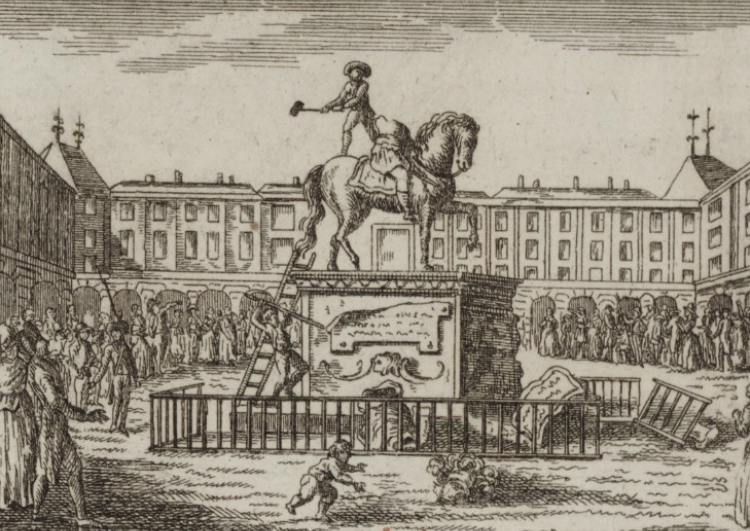
The French Revolution also saw monumental unrest in its cities. In the Revolution’s opening salvo, the mob targeted the Bastille, the embodiment of the anti-democratic excesses of the ancien régime. Later that year, a statue of Louis XV was dismantled on what would become the Place de la Concorde. 1792 saw révolutionnaires topple equestrian statues of King Louis XIV in the Place Vendôme and of Henri VI on the Pont Neuf. They repurposed their metal to cast cannons. Enemies of the monarchy destroyed countless other relics which they deemed to be anti-democratic throughout the Reign of Terror.
In the place of royalist statues, Napoleon I constructed monuments to his First Empire. Most notably, the Emperor built an approximation of Trajan’s Column in the Place Vendôme on the former site of the shrine to Louis XIV. Atop the Column he placed his own likeness in bronze. After Waterloo, the newly empowered Bourbons tore down the Vendôme Column’s imperial ornament in 1815 and recast it as a replica of the original statue of Henri VI. It appeared on the Pont Neuf in 1818. Good King Henry looks down on central Paris’s tourist throngs to this day.
7. The Vendôme Column and the Paris Commune
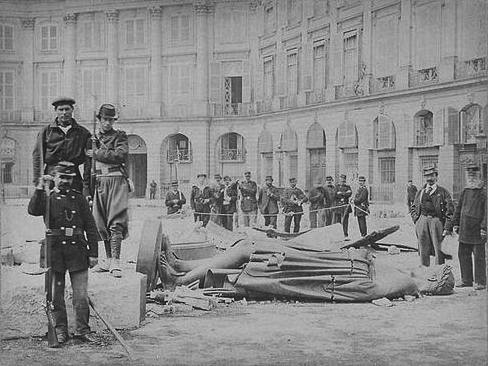
Henry IV might have survived the political turmoil of 19th-century France, but the Vendôme Column continued to be an icon contested by successive regimes. Seeking to solidify the Second Empire’s claims to world domination, Napoleon III outfitted the Column with a new bronze of his uncle in Roman military regalia. Realist painter Gustave Courbet pegged the reconstructed ornament as a “nationalistic symbol of tyranny and militarism.” When the communards took power in the spring of 1871, they toppled it as such. After the fall of the Commune, government officials of the Third Republic forced Courbet to pay for the Column’s full reconstruction to the tune of 323,091 francs. Napoleon I certainly came out on top in this episode.
8. Iconoclasm of Monuments to British Imperialism
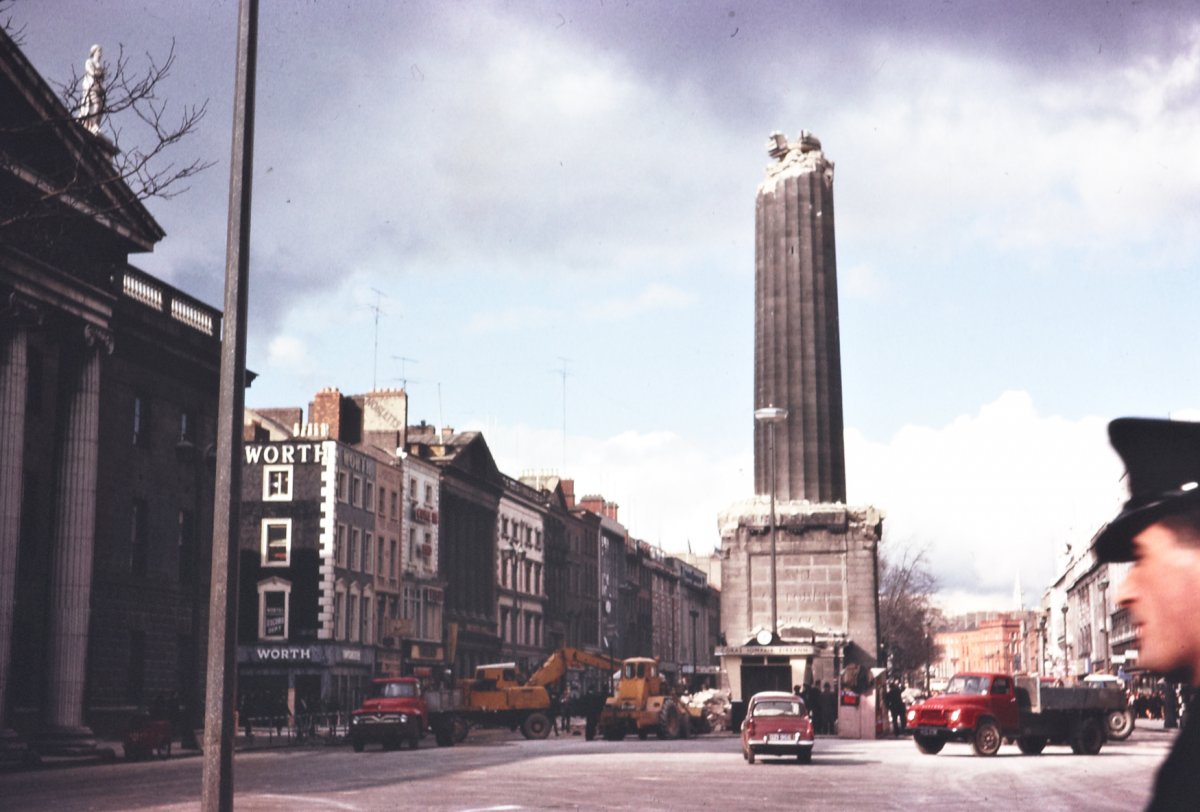
In an effort to stake political claims in their colonial possessions, British agents constructed monuments to imperial authority from the Empire’s outset right through the 20th century. In the wake of his victory at Cape Trafalgar in 1805, Horatio Nelson was memorialized in many colonial cities. After King George V deemed New Delhi the successor to Calcutta as capital of India in 1911, he erected a fifty foot tall statue of himself to reign over it.
Enemies of the Empire recognized the power of these statues and targeted them for removal, with increasing frequency after the beginning of decolonization. In 1968, Indian officials moved the statue of George V to Delhi's Coronation Park, which serves as a graveyard of British imperial monuments. As Steve Coll writes, “New Delhi had not erased its imperial origins; it had collected painful symbols of it and then allowed their potency to dissolve.” Such iconoclasm took place in former British (and more generally, European) possessions around the world on their roads to independence. In 1975, Angolans pulled down many a marker of Portuguese occupation; Haitians did the same to a statue of Christopher Columbus in 1986.
9. Post-Soviet Iconoclasm
Throughout the new Soviet Republics, more than 500 tsarist monuments were destroyed in 1918. In their stead, communists erected statues to their leaders. But these would not stand without challenge. Hungarians tore down statues to Stalin during their 1956 rebellion. Shortly after the fall of the Berlin Wall, the post-Soviet world saw widespread destruction of socialist iconography from Vladivostok to Vilnius. Outside of KGB headquarters in Moscow, the statue of Felix “Iron Felix” Dzerzhinsky, founder of the Soviet secret police, was replaced by a monument to those who suffered in Stalin’s gulag.
Nationalist symbols often replaced Soviet ones. In the 1990s, Iron Felix was relegated to Fallen Monument Park, an open air sculpture museum for around 700 Soviet artworks. A similar museum, colloquially known as “Stalin World,” also exists in Lithuania. Many busts of Lenin, Marx, and Engels are on view in Budapest’s Szoborpark (Memento Park), established in 1993. The architect who designed the museum once said that “this park is about dictatorship. And at the same time ... this park is about democracy. After all, only democracy is able to give the opportunity to let us think freely about dictatorship.” But you won't be able to think freely for free. While millions of citizens of the Hungarian People’s Republic viewed Soviet statues without having to pay, you’ll have to fork over the entrance fee to see them today.
10. A Monumental End to the Battle of Baghdad
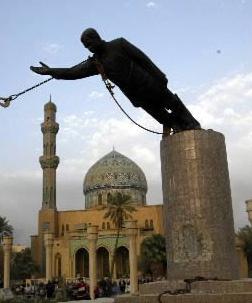
In 2002, to commemorate his 65th birthday, Saddam Hussein erected a 40-foot statue to himself in central Baghdad’s Firdos Square. Following the 2003 American invasion of Iraq, some one hundred Iraqis gathered in the Square with U.S. troops to pull the monument to the Baathist dictator. With the media’s help, this scene generally entered the Western imagination as a convenient bookend to the Battle of Baghdad. But the protracted conflict that began with the Second Gulf War did not end with the destruction of a statue. In fact, it continues to this day. Nevertheless, this episode proves that iconoclasm is at least as powerful a weapon in the battle for collective memory as monument building.
